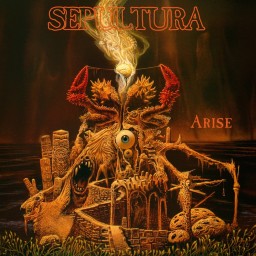 Review by Ben for Sepultura - Arise (1991)
Review by Ben for Sepultura - Arise (1991)
More exhilirating thrash metal from the Brazilian legends with a few more influences added to the mix.
Beneath the Remains was a massive hit for Sepultura that opened up stacks of possibilities for the Brazilians. All of a sudden they were on the lips of almost everyone in the metal scene and due to their exotic origins had even piqued the interest of the non-metal media abroad. The big question that needed answering was whether the band’s fourth full length album could continue the massive momentum that suggested Sepultura was about to hit the big time in a huge way. Unsurprisingly given the success of the union, the band were keen to work with Scott Burns again, but rather than bring him over to Brazil as they did for Beneath the Remains, Sepultura decided to relocate to the United States. Taking up residence in Phoenix, Arizona where they obtained new management, Sepultura’s next album would be recorded at Burns’ customary base, Morrisound Studios, with far superior equipment than anything the band had used previously. With an increased budget of $40000, as opposed to the measly $8000 they had for the last album, these improved recording circumstances would certainly assist Sepultura in upping the ante from a production point of view. With former monetary and time restrictions removed, the Brazilians could concentrate on creating another thrash metal classic.
Released on March the 20th 1991, Arise would be exactly that, confirming Sepultura as the most significant band in the metal scene at the time. Any suggestions that their extraordinary success might cause a drop in intensity and aggression were forgotten after one look at Michael Whelan’s nightmarish Lovecraft-inspired artwork. It may have no real relevance to the album themes, but it’s unquestionably one of the more memorable and fascinating covers you’ll come across. Once the title track kicks in there’s little doubt remaining that Arise packs a serious punch and the new production increases Sepultura’s already significant potency. As far as songwriting goes, Arise is really a continuation of Beneath the Remains, which means dynamic thrash metal with death metal intensity, but the band members were clearly gaining confidence and showing signs of integrating other influences into their sound. Small snippets of samples and effects hint at the industrial edge they would delve into further on Chaos A.D., while Igor was experimenting with more grooving rhythms and even tribal elements (on Altered State) that would become far more prevalent on later works. It has to be said that his drumming is a highlight of Arise and shows quite clearly how talented the man is.
Max finally seems to have overcome the language barrier at this stage and puts in his best performance to date. You wouldn’t know from reading the lyrics or listening to the album that none of the band members could yet speak English (there are still some minor blemishes mind you) which is not something you can say when checking out earlier Sepultura releases. Scott Burns is actually listed as assisting in lyric translation and there’s no doubt the improved grammar helps to give the tracks more conviction. There are countless awesome riffs to be found on Arise and the dynamic way in which they are structured makes for one of the most exciting experiences a thrash metal fan can have. Many of those fans will name Beneath the Remains as their favourite Sepultura release, but Arise is without question the most entertaining of their albums for me. The former is indeed a classic and more groundbreaking in the overall scheme of things, but the production quality of Arise combined with its fist-pumping consistency make it my weapon of choice. Highlights abound whether they be the rush of the title track, the restrained yet rousing Dead Embryonic Cells and Desperate Cry, the tribally introduced expansive Altered State or the blistering closer Infected Voice. Arise finds Sepultura at the peak of their powers and is an essential part of any metal fan’s collection.
